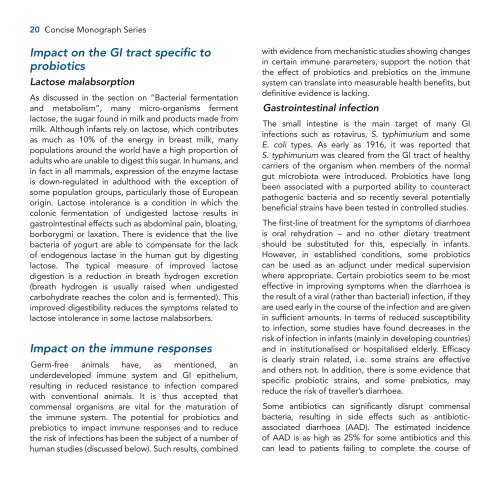probiotics, prebiotics and the gut microbiota - International Life ...
probiotics, prebiotics and the gut microbiota - International Life ...
probiotics, prebiotics and the gut microbiota - International Life ...
You also want an ePaper? Increase the reach of your titles
YUMPU automatically turns print PDFs into web optimized ePapers that Google loves.
20 Concise Monograph SeriesImpact on <strong>the</strong> GI tract specific to<strong>probiotics</strong>Lactose malabsorptionAs discussed in <strong>the</strong> section on “Bacterial fermentation<strong>and</strong> metabolism”, many micro-organisms fermentlactose, <strong>the</strong> sugar found in milk <strong>and</strong> products made frommilk. Although infants rely on lactose, which contributesas much as 10% of <strong>the</strong> energy in breast milk, manypopulations around <strong>the</strong> world have a high proportion ofadults who are unable to digest this sugar. In humans, <strong>and</strong>in fact in all mammals, expression of <strong>the</strong> enzyme lactaseis down-regulated in adulthood with <strong>the</strong> exception ofsome population groups, particularly those of Europeanorigin. Lactose intolerance is a condition in which <strong>the</strong>colonic fermentation of undigested lactose results ingastrointestinal effects such as abdominal pain, bloating,borborygmi or laxation. There is evidence that <strong>the</strong> livebacteria of yogurt are able to compensate for <strong>the</strong> lackof endogenous lactase in <strong>the</strong> human <strong>gut</strong> by digestinglactose. The typical measure of improved lactosedigestion is a reduction in breath hydrogen excretion(breath hydrogen is usually raised when undigestedcarbohydrate reaches <strong>the</strong> colon <strong>and</strong> is fermented). Thisimproved digestibility reduces <strong>the</strong> symptoms related tolactose intolerance in some lactose malabsorbers.Impact on <strong>the</strong> immune responsesGerm-free animals have, as mentioned, anunderdeveloped immune system <strong>and</strong> GI epi<strong>the</strong>lium,resulting in reduced resistance to infection comparedwith conventional animals. It is thus accepted thatcommensal organisms are vital for <strong>the</strong> maturation of<strong>the</strong> immune system. The potential for <strong>probiotics</strong> <strong>and</strong><strong>prebiotics</strong> to impact immune responses <strong>and</strong> to reduce<strong>the</strong> risk of infections has been <strong>the</strong> subject of a number ofhuman studies (discussed below). Such results, combinedwith evidence from mechanistic studies showing changesin certain immune parameters, support <strong>the</strong> notion that<strong>the</strong> effect of <strong>probiotics</strong> <strong>and</strong> <strong>prebiotics</strong> on <strong>the</strong> immunesystem can translate into measurable health benefits, butdefinitive evidence is lacking.Gastrointestinal infectionThe small intestine is <strong>the</strong> main target of many GIinfections such as rotavirus, S. typhimurium <strong>and</strong> someE. coli types. As early as 1916, it was reported thatS. typhimurium was cleared from <strong>the</strong> GI tract of healthycarriers of <strong>the</strong> organism when members of <strong>the</strong> normal<strong>gut</strong> <strong>microbiota</strong> were introduced. Probiotics have longbeen associated with a purported ability to counteractpathogenic bacteria <strong>and</strong> so recently several potentiallybeneficial strains have been tested in controlled studies.The first-line of treatment for <strong>the</strong> symptoms of diarrhoeais oral rehydration – <strong>and</strong> no o<strong>the</strong>r dietary treatmentshould be substituted for this, especially in infants.However, in established conditions, some <strong>probiotics</strong>can be used as an adjunct under medical supervisionwhere appropriate. Certain <strong>probiotics</strong> seem to be mosteffective in improving symptoms when <strong>the</strong> diarrhoea is<strong>the</strong> result of a viral (ra<strong>the</strong>r than bacterial) infection, if <strong>the</strong>yare used early in <strong>the</strong> course of <strong>the</strong> infection <strong>and</strong> are givenin sufficient amounts. In terms of reduced susceptibilityto infection, some studies have found decreases in <strong>the</strong>risk of infection in infants (mainly in developing countries)<strong>and</strong> in institutionalised or hospitalised elderly. Efficacyis clearly strain related, i.e. some strains are effective<strong>and</strong> o<strong>the</strong>rs not. In addition, <strong>the</strong>re is some evidence thatspecific probiotic strains, <strong>and</strong> some <strong>prebiotics</strong>, mayreduce <strong>the</strong> risk of traveller’s diarrhoea.Some antibiotics can significantly disrupt commensalbacteria, resulting in side effects such as antibioticassociateddiarrhoea (AAD). The estimated incidenceof AAD is as high as 25% for some antibiotics <strong>and</strong> thiscan lead to patients failing to complete <strong>the</strong> course of
















